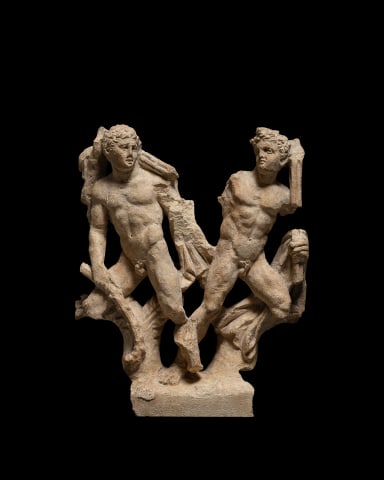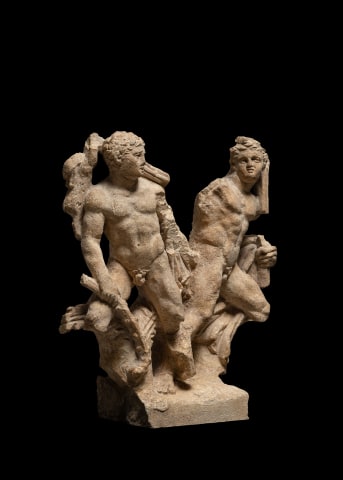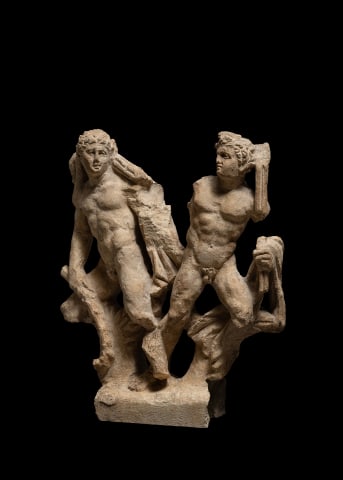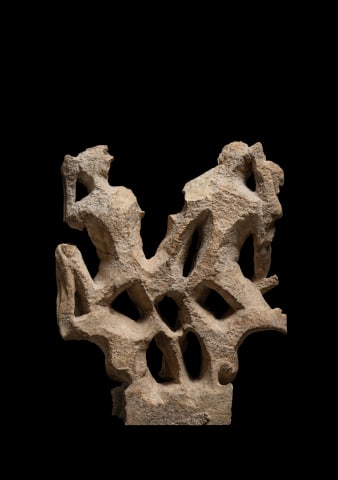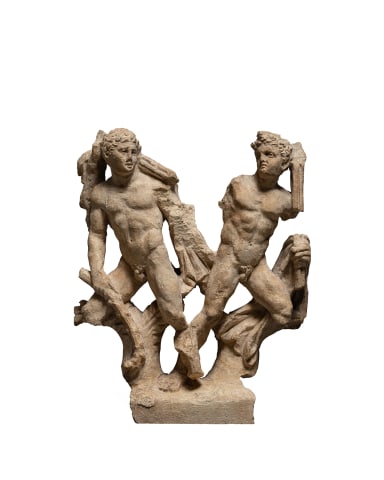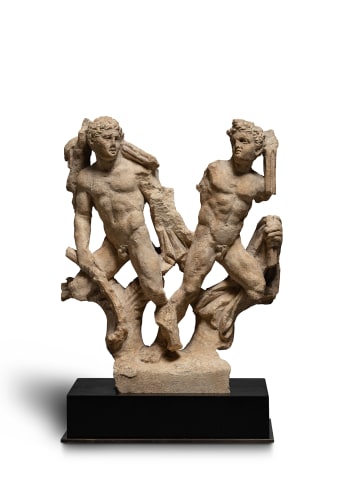Greek sculptural group of Pirithous and Theseus, South Italy, Tarentum, c.325-250 BC
Limestone
Height: 24cm, width: 19.5cm
10894 TA
£ 48,000
Further images
A freestanding, deftly chiselled group, composed of the heroes Pirithous and Theseus out hunting, both are shown in heroic nudity with short, curly hair and strong musculature, advancing away from...
A freestanding, deftly chiselled group, composed of the heroes Pirithous and Theseus out hunting, both are shown in heroic nudity with short, curly hair and strong musculature, advancing away from one another. Their quarry, a rabbit, is hanging from a bunch of spears held over the shoulder of the left-hand figure, whose right hand grasps a lagobolon, a type of knobbly hunting stick, which he holds against his right thigh, his left leg overlapping that of the figure beside him, and his head twisted to his left and gazing straight ahead. The lower body of the second figure, whose strong diagonals mirror his companion’s stance, is framed by the folds of his cloak which falls behind his left leg. He also grasps a bunch of hunting spears held vertically in his left hand, behind him is the base of a tree trunk whilst acanthus leaves arch upward between the legs of his companion. Recomposed from several large fragments, some scratches to the surface toned down.
In other examples of this scene the figure holding the lagabolon has been identified as Pirithous, and the other as Theseus.
This fragmentary, freestanding group was attached to the top of a funerary shrine, or ‘naiskos’. From 325-250 BC naiskoi tombs were commonplace in Tarentum, a Greek colony in South Italy. They were decorated with pedimental relief figures, acroteria, metopes and sculpted friezes. Their existence is best attested to in local red-figured vases of the period. These naiskoi were carved from the local limestone and were mainly reserved for the tombs of the wealthy.
The friendship of Pirithous and Theseus is an appropriate theme for a funerary monument. In Greek mythology the pair bonded after Pirithous picked a fight with Theseus, wanting to challenge his rumoured courage and strength. When neither was able to overcome the other they swore an oath of friendship and together had many adventures, including the hunt for the Calydonian boar, and the centauromachy at the wedding of Pirithous to Hippodamia. After each had been widowed, the two declared that only a daughter of Zeus could be an appropriate wife for them each, so after the former had abducted Helen of Sparta (later to be known as Helen of Troy), they descended into the underworld to abduct Persephone, the wife of Hades, so that she might become become the consort of Pirithous and adopt the role as Queen of the Lapiths. Hades caught them, held them captive and set the Furies to torture them. Years later, Herakles was performing the last of his labours, to capture Cerberus, and on his way back from the afterlife saw his cousin Theseus, with Pirithous, tied to a rock and rescued him. Tragically for Pirithous, Hades deemed his actions too unforgivable in comparison to those of Theseus, and never allowed him to return to the land of the living. This myth creates a link between the worlds of the living and the dead, and would act as a reminder of the heroic actions of the young, the sacrifices one makes for brotherly friendship and for the pursuit of a woman's love, and the mix of eternity and transience of the underworld.
The symmetry in the contrasting movements seen here is accentuated by the overlapping legs and the vegetal supports, creating a series of intersecting diagonals. Jucker (op. cit., p.21) notes that the group tilts forward, indicating that it must have been attached to the upper part of the naiskos. As there are no visible traces on the back to suggest that the figures were fixed to a background, the group would have most likely been free standing.
In other examples of this scene the figure holding the lagabolon has been identified as Pirithous, and the other as Theseus.
This fragmentary, freestanding group was attached to the top of a funerary shrine, or ‘naiskos’. From 325-250 BC naiskoi tombs were commonplace in Tarentum, a Greek colony in South Italy. They were decorated with pedimental relief figures, acroteria, metopes and sculpted friezes. Their existence is best attested to in local red-figured vases of the period. These naiskoi were carved from the local limestone and were mainly reserved for the tombs of the wealthy.
The friendship of Pirithous and Theseus is an appropriate theme for a funerary monument. In Greek mythology the pair bonded after Pirithous picked a fight with Theseus, wanting to challenge his rumoured courage and strength. When neither was able to overcome the other they swore an oath of friendship and together had many adventures, including the hunt for the Calydonian boar, and the centauromachy at the wedding of Pirithous to Hippodamia. After each had been widowed, the two declared that only a daughter of Zeus could be an appropriate wife for them each, so after the former had abducted Helen of Sparta (later to be known as Helen of Troy), they descended into the underworld to abduct Persephone, the wife of Hades, so that she might become become the consort of Pirithous and adopt the role as Queen of the Lapiths. Hades caught them, held them captive and set the Furies to torture them. Years later, Herakles was performing the last of his labours, to capture Cerberus, and on his way back from the afterlife saw his cousin Theseus, with Pirithous, tied to a rock and rescued him. Tragically for Pirithous, Hades deemed his actions too unforgivable in comparison to those of Theseus, and never allowed him to return to the land of the living. This myth creates a link between the worlds of the living and the dead, and would act as a reminder of the heroic actions of the young, the sacrifices one makes for brotherly friendship and for the pursuit of a woman's love, and the mix of eternity and transience of the underworld.
The symmetry in the contrasting movements seen here is accentuated by the overlapping legs and the vegetal supports, creating a series of intersecting diagonals. Jucker (op. cit., p.21) notes that the group tilts forward, indicating that it must have been attached to the upper part of the naiskos. As there are no visible traces on the back to suggest that the figures were fixed to a background, the group would have most likely been free standing.
Provenance
Freddie Küng Antiquitäten, Lucerne, SwitzerlandDr. Anton Pestalozzi (1915-2007), Zurich, Switzerland; acquired from the above 28th March 1979, thence by descent
Literature
For a closely related parallel, see J.C. Carter, “The Sculpture of Taras” in Transactions of the American Philosophical Society, vol.65, no.7 (Philadelphia, 1975), p.88, pl.54aFor a red-figure vase painting from South Italy showing the myth of Peirithous and Theseus see David Saunders (ed.), Underworld: Imagining the Afterlife in Ancient South Italian Vase Painting (Los Angeles, 2021), pp.118-120, no.3. For an example when the figure with a lagobolon is identified as Pirithous see ibid., no.22, pp.166-171
Publications
Arachne, entity ID 1140687I. Jucker, Skulpturen der Antiken-Sammlung Ennetwies (Mainz am Rhein, 2006), Band 2, pp.20-24, no.5, pl.9
